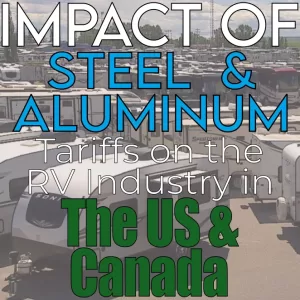 The recreational vehicle (RV) industry, a significant contributor to the North American economy, faces potential disruption from recently enacted tariffs on steel and aluminum imports. These tariffs, aimed at bolstering domestic production, have raised concerns about their impact on the RV sector, particularly for those considering full-time RV living. This report delves into how these tariffs could affect the RV industry in both the US and Canada, with a focus on the new and used RV market and implications for full-time RVers.
The recreational vehicle (RV) industry, a significant contributor to the North American economy, faces potential disruption from recently enacted tariffs on steel and aluminum imports. These tariffs, aimed at bolstering domestic production, have raised concerns about their impact on the RV sector, particularly for those considering full-time RV living. This report delves into how these tariffs could affect the RV industry in both the US and Canada, with a focus on the new and used RV market and implications for full-time RVers.
President Trump recently signed proclamations increasing tariffs on steel and aluminum imports to a flat 25% without exceptions or exemptions. This move, while appearing to support struggling domestic industries, carries the risk of triggering a trade war with key partners like Canada, Mexico, and the European Union. Canada, as the largest exporter of aluminum to the US, is particularly vulnerable to these tariffs. The RV industry relies heavily on both steel and aluminum for manufacturing, making the potential impact of these tariffs significant. Elkhart County, Indiana, a major hub for RV production, generates nearly 80% of the global RV supply, underscoring the industry’s importance to the region and the potential economic consequences of these tariffs. For individuals considering full-time RV living, these tariffs could translate to higher costs for both new and used RVs, potentially influencing their decision to embrace the lifestyle.
Proportion of Steel and Aluminum in RV Manufacturing
RVs use both steel and aluminum in their construction. Steel is commonly used for the chassis, providing structural integrity, while aluminum, favored for its lightweight and corrosion-resistant properties, is used in components like framing, siding, and trim. The exact proportion of each metal varies depending on the RV type and manufacturer.
Sources of Steel and Aluminum for RV Manufacturers
RV manufacturers in the US and Canada source steel and aluminum from various suppliers. Some key players include:
| Company | Products/Services |
|---|---|
| Eagle Aluminum | Specializes in aluminum RV trim, trailer trim, and extrusions. |
| National RV Siding LTD. | Offers custom-produced aluminum siding and steel cladding for RVs. |
| Interstate RV Metal and Supply | Offers a range of RV accessories and supplies, including aluminum and fiberglass siding. |
Impact on the RV Industry
Increased Costs
Tariffs on steel and aluminum will likely increase the cost of RVs. One RV company president estimates that 95% of RVs sold in Canada are manufactured in the US, and the tariffs will lead to significant price increases. This is compounded by the unfavorable exchange rate for the Canadian dollar, further increasing RV costs for Canadian consumers. This creates a “double hit” for the industry, squeezing profit margins and potentially impacting sales.
Economists predict that tariffs could raise the price of a typical car, which has about 1,000 pounds of steel, by $1,000 to $1,500. Given the significant use of steel and aluminum in RVs, similar price increases can be expected in the RV market. Moreover, tariffs on steel can have a ripple effect, increasing the cost of various components used in RVs beyond just the raw materials themselves. This could disproportionately affect lower-priced RVs or those with higher steel and aluminum content, making them less affordable for consumers. In addition to these direct cost increases, economists and Wall Street analysts warn that new U.S. tariffs could cause inflation to flare. This broader economic impact could further worsen cost increases for both manufacturers and consumers.
Potential Impact on Demand
Increased prices due to tariffs could dampen demand for new RVs. Consumers may delay purchases or opt for used RVs, potentially affecting new RV sales. However, some consumers might accelerate their purchases to avoid future price hikes, leading to a short-term increase in demand.
Furthermore, the potential for retaliatory tariffs from Canada poses a significant threat to the US RV industry. Canada is the largest international buyer of US-made RVs, and tariffs on US RV exports could significantly change demand and sales. In 2024, the US RV industry shipped nearly 30,000 units to Canada, with an estimated retail value of over $1.7 billion. Any disruption to this trade flow could have a substantial impact on the industry.
Supply Chain Disruptions
The tariffs could disrupt the RV industry’s supply chain. About half of the materials used in American-made RVs, including steel and aluminum, come from Canada. Tariffs and potential retaliatory measures from Canada could disrupt this flow of materials, affecting production and potentially leading to delays.
The tariffs also introduce new rules of origin for steel and aluminum. The “melt and pour” rule for steel and “smelt and cast” rule for aluminum require that these metals be melted and processed in the US to avoid tariffs. This could affect sourcing decisions for RV manufacturers, potentially forcing them to shift to US suppliers or face increased costs for imported materials. This shift could further disrupt the supply chain and potentially lead to increased production costs.
Impact on Used RV Market
The tariffs might increase demand for used RVs as consumers look for more affordable options. This could lead to higher prices and a tighter supply in the used RV market.
Impact on RV Accessories and Aftermarket
The tariffs could also affect the cost of RV accessories and aftermarket products. Many RVers rely on accessories like solar panels for off-grid power, and tariffs on these items could increase costs by up to 30%. This could affect RVers’ ability to adopt these technologies and potentially change their overall RVing experience.
Dealership Strategies and Inventory Management
In anticipation of tariffs, some dealerships might stockpile inventory to mitigate short-term price increases. This strategy could help support stable prices for consumers in the short term but might also lead to inventory imbalances in the long run. If demand does not meet expectations, dealerships could be left with excess inventory, potentially leading to price reductions or financial losses.
Some Canadian RV dealerships have also announced that they will cancel their US orders in retaliation, if tariffs proceed.
Impact on Employment
The tariffs could have a negative impact on employment in the RV industry, particularly in Elkhart County, Indiana, where a significant portion of RV manufacturing takes place. If tariffs lead to decreased production or sales, companies might be forced to reduce their workforce or implement layoffs. This could have a significant impact on the local economy and the livelihoods of those employed in the RV sector.
Government Support and Initiatives
While there are no specific government support programs for the RV industry in response to the tariffs, the RV Industry Association (RVIA) is actively advocating for policies that support the industry. They are engaging with government officials and industry stakeholders to address concerns and mitigate the potential negative impacts of the tariffs. The RVIA is also working to close the de minimis loophole on Chinese imports, which has allowed low-quality imports to undercut American businesses in the RV aftermarket sector.
Conclusion
The new steel and aluminum tariffs present both challenges and opportunities for the RV industry in the US and Canada. While increased costs and potential supply chain disruptions are major concerns, the industry might also see increased demand for used RVs and potential benefits from government advocacy efforts. The long-term impact of the tariffs will depend on various factors, including the duration of the tariffs, retaliatory measures from trading partners, and the industry’s ability to adapt to the changing landscape.
In the short term, the tariffs are likely to lead to increased prices for RVs and accessories, potentially dampening demand for new RVs and affecting sales. The industry may also experience supply chain disruptions due to changes in sourcing and potential retaliatory measures from Canada. This could lead to production delays and further cost increases.

